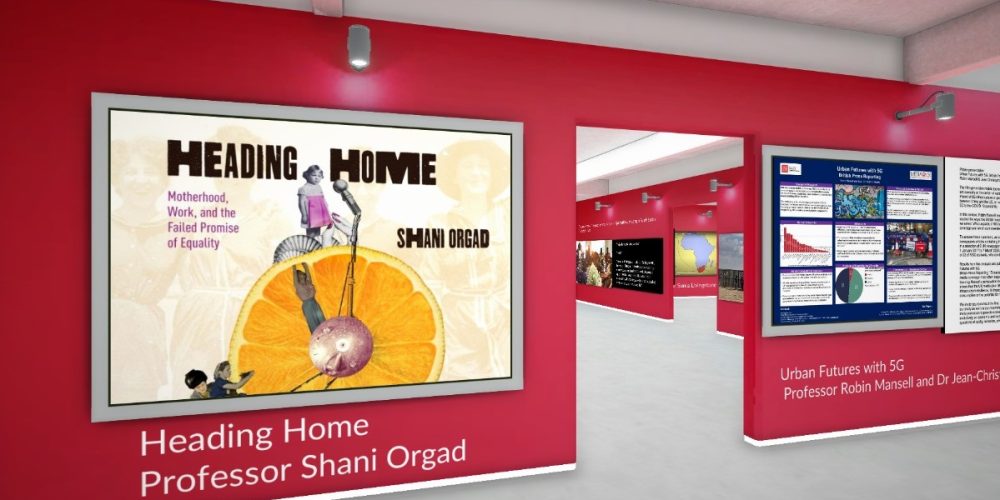About Media@LSE
The Department of Media and Communications is a world-leading centre for education and research in communication and media studies at the heart of LSE’s academic community in central London.
Media@LSE aims to encourage informed and insightful discussion around the vital role of media and communications in contemporary society, bringing the research and expertise of LSE’s Department of Media and Communications to a wider audience that includes fellow academics, civil society, policy makers, journalists, the broader media industry, and other stakeholders.
The Problem: COVID-19 Barrier in Celebrating the Launch of the Brand Media@LSE
Back in the new year, colleagues in the Department got together and thought it would be very interesting to have a formal launch to celebrate the introduction of the brand Media@LSE. When discussing this idea, they had no idea though that in a few months, the prospect of having a launch, perhaps, followed by a drink’s reception would be impossible. COVID-19 represented a real barrier to these plans naturally, but this did not mean they had to scrap the concept completely.
A physical event would require booking a space on the LSE campus, arrange printing and installation for the exhibition boards, organize flyers/promotional material, and catering for the launch reception. By having an online exhibition, they could also be more creative with the space available.
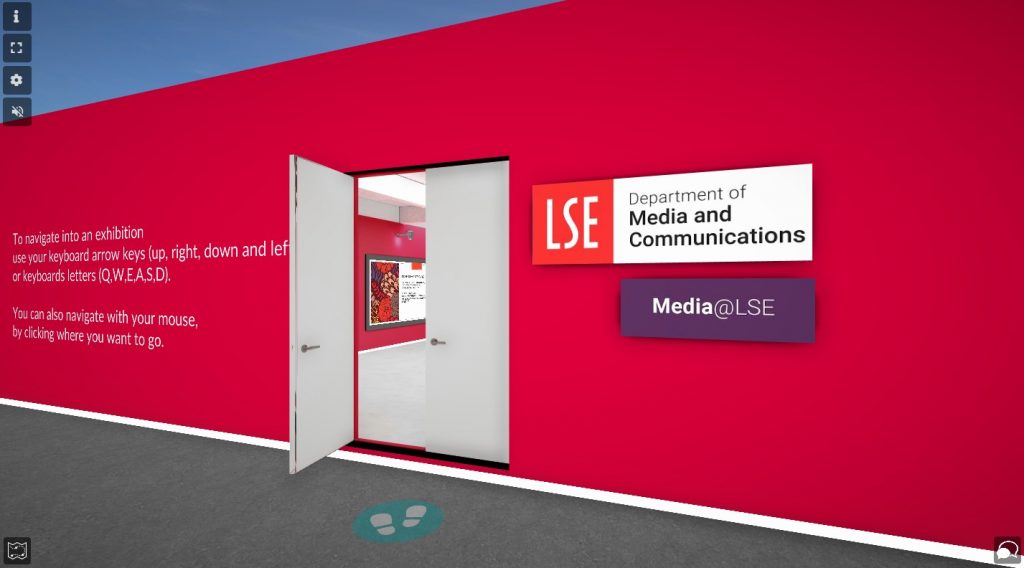
The Solution: Creating an Online Virtual Exhibition with Artsteps
The Media@LSE team within the Department, sat down (on Zoom!) to discuss alternative ways of engaging with the idea of an exhibition. Although they were hindered by the obvious practicalities, this did not mean that the idea was conceptually impossible. As the world was moving online, they too thought that it may be possible to move their exhibition into the online sphere. From thereon, it was their task to create an exhibition online that represented the work of the Department in full. Because this was new terrain for them, they needed to have a plan about how this would be possible.
Firstly, a great deal of time was spent researching other examples of online exhibitions. At the time, museums in London were moving towards putting their research online. “Constrained by the issue that we did not have the same access of resources that they did, we could not pursue the same avenues”, Silas Scott, Research Administrator of the Department of Media and Communications explains.
Rather, a colleague in the Department recommended a website called Artsteps where personalized online exhibitions can be built. On the platform, there are ready to use templates that can be selected when building your exhibition. None of these seemed quite appropriate for the Department’s identity, and as such, a partnership with Artsteps was achieved to help build their own tailored exhibition by using the Private Space service.
Using Artsteps’ Private Space allowed Media@LSE to design and create a custom exhibition with the ability to secure their 3D virtual space under a unique domain name e.g. myownspace.artsteps.com and a personalized curating panel with their branding.
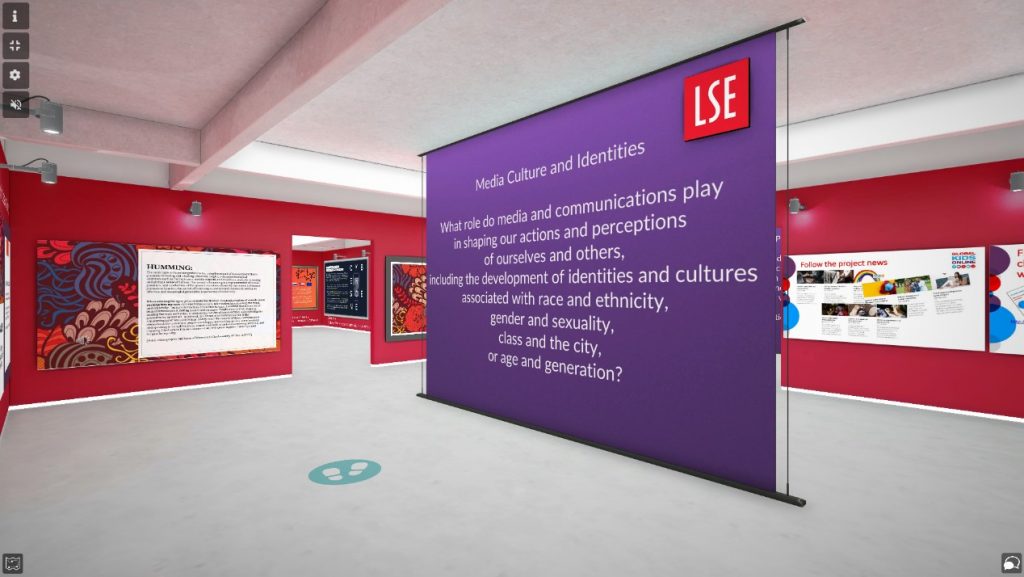
The Exhibition Approach
Media@LSE decided that the exhibition should best represent the research themes of the Department. The exhibition would be a means of promoting the Department’s work in its fullest, and this meant representing the wide array of research.
“As a Department, we are very focused on engaging PhD Researchers and Masters students in the research of the Department, and the exhibition was no exception to this” Silas Scott, says. This year, the Department ran a project called Media City London, focusing on the diverse ways the media engages and influences with London. Many of the Department’s Masters students were involved in this research, whose work would be highlighted through the exhibition.
When deciding on how the exhibition would be laid out, Media@LSE wanted the layout to be divided into four rooms, which represented the research themes of the Department:
– Media Culture and Identities
– Media Participation and Politics
– Communication Histories and Futures
– Communication, Technology, Rights and Justice
They wanted to express the depth and breadth of the Departmental research so it was of upmost importance to reflect all the four themes.
On the day of the exhibition launch, Media@LSE hosted a panel where four members of Faculty – one from each of the research themes spoke about their research. This panel acted as a way of unveiling the exhibition to the general public.
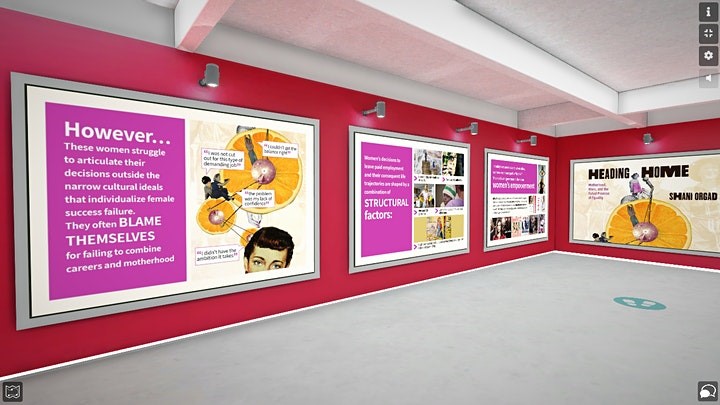
The Results
The exhibition was a massive success. The audience enjoyed the event and since then a number of other academic Departments have been in touch to enquire about having their own exhibitions.
A virtual exhibition allowed to share the work with a global audience. With a physical exhibition, a space would need to be booked for a limited time on the LSE campus in London. As well, also possibly sharing the space with other exhibitors. However, with an online exhibition, it allowed people to view the exhibition from their personal devices wherever they are in the world. ¨It was certainly a learning experience too. During these difficult times it is a wonderful way to connect with a global audience¨, Silas says.
There are some limitations with accessibility and communicating online to audiences, however, this was a good opportunity to test out how as a department their research can be shared and to engage with a wider community. A Media and Communications Department strives to be on the cutting-edge of these new trends and opportunities.
Tweet responses:
– This interactive virtual exhibition setup is so cool!
– Such a creative and engaging way to share the research, virtual exhibition by @MediaLSE
– Just enjoyed panel discussion showcasing work @MediaLSE – now heading through the virtual door to navigate the exhibition.
– A cool and creative idea for our #Covid_19 times: a virtual #exhibition to showcase some of the research works done by our @MediaLSE Department
Testimonial
“My research team and I came across the Artsteps platform just when the Media@LSE research exhibition had to move online due to the pandemic. Different from the traditional and available ways of sharing research such as writing blog posts or making academic posters that we could think of at that time, this virtual exhibition platform allows for a visual and interactive space that is perfect for engaging a wide audience. It works especially well with our Digital City London project as it is a project that sets out to map the visual geography of the vibrant and multicultural neighborhoods of London. We were able to visualize our research by using different visual formats such as photography, videos, and social media. Other than that, it also gave us the chance to closely collaborate with different members of the department to plan and produce a space, just like how we would offline. The final results of the virtual exhibition are amazing and many of my classmates from all over the world were able to easily access it despite of the physical distance. It’s been a wonderful experience working with this new virtual exhibition tool!” Jessica Su, said.
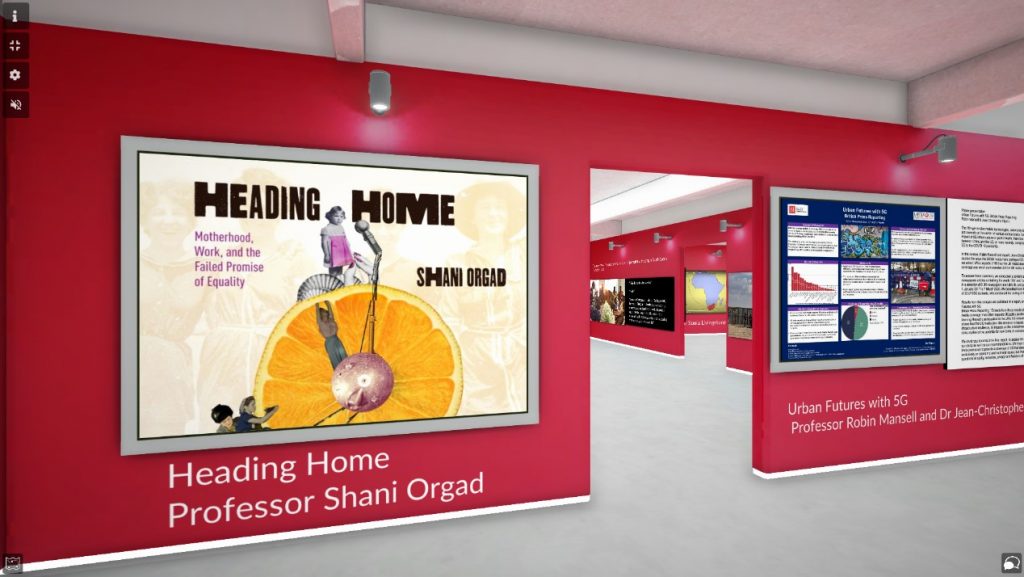
COMPANY: Artsteps

